You’ve learnt to play chords. You’ve learnt to play scales. In this lesson, we are going to look at arpeggios.
Arpeggios, put simply, are chords that are broken up into single notes. When we play a chord, we play multiple notes all at once. When we play an arpeggio, we play these same notes, but one by one. Technically speaking, if you form a chord with your left hand and strike each individual string one by one, you are playing an arpeggio. But playing arpeggio in this way is kind of cheating. To understand this, we need to look at just a little bit of chord theory.
What’s In A Chord Anyway?
Chords are built up from individual notes of a Major scale (have I mentioned that Major scales are important?). Let’s look at the A Major chord. The major chord is made up of the following notes of the major scale:
- 1 – 3 – 5
Therefore, the A Major chord contains the following notes:
- A (1st note of A Major scale)
- C# (3rd note of A Major scale)
- E (5th note of A major scale)
A major chord = A – C# – E
It’s that simple. On the guitar however, we usually complicate chords by doubling up on notes. As we now know, the A major chord is made up of the notes A, C# and E. Let’s look an open A chord and put the theory to the test:


If the major chord contains only 3 notes, how is it that we are playing 5 strings? Because we are doubling up on notes. Look at the same image with markings.

As you can see, we have started with the 1st (root note), then played the 5th note, then the root note again (up one octave), then the 3rd and then the 5th again (up one octave).
Put simply, when we play chords on the guitar, we usually change the order of notes and double up on notes. We do this because doubling up on notes and changing the order around does not change the essence or function of the chord. Think of it as changing the color of the chord slightly, but from a functional point of view, an A major chord is an A major chord no matter how many times you double up on notes or change the order. It’s also partly because of the layout of the guitar. The notes on the guitar are not organised as clearly and logically as the notes on a piano. By necessity, when we play chords on the guitar, we are limited to the notes in any given position. We have to work with what we’ve got, depending on where we are. Therefore, we often arrange the notes in a chord based on what the position allows. It is impossible to play more than one note on each string, which again creates limitations to how chords are formed.
This long winded explanation is useful for two reasons. Firstly it helps you to better understand what chords are. When you really understand chords well, you can create your own voicings (combinations of notes within a chord). We start off learning chords in a very basic way (‘this is how you play an A major chord… this is how you play a D minor chord’ etc.), but when you know the theory, forming chords presents a vast array of infinite possibilities. Secondly, we want to learn about arpeggios. You need to understand chords on a fundamental level before understanding arpeggios.
How To Play Arpeggios
When we play arpeggios, we organize the notes of a chord in order. I mentioned earlier that technically speaking, if you formed an A major chord with your left hand and played each string individually, you would be playing an A Major arpeggio. But I also said that that would be cheating. Playing an open A major chord in this way (based on the shape that is inserted above) would result in the following:
- 1 (A) – 5 (E) – 1 (A) – 3 (C#) – 5 (E)
What we really want when playing arpeggios is the notes of the chord in order, such as:
- 1 – 3 – 5
Also, we don’t want it to sound like we are just playing each string of a chord one at a time. We want to play the notes in a way that it almost sounds like we are playing a scale.
When we play arpeggios, we can play through as many octaves as we like (1 – 3 – 5 – 1 – 3 – 5 etc) but the notes should be played in numerical order. By playing arpeggios in this way, we can approach them like scales and learn each arpeggio in five different positions.
Let’s go back to the A Major chord that we were analysing before. We can play this arpeggio in the 4th position of the guitar in the following way:
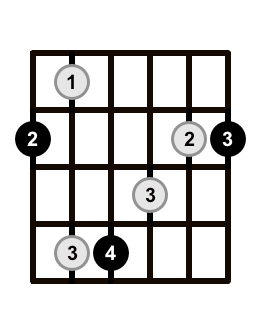

Based on the lesson on scales, you should know how to interpret the ‘shape’ (first picture) in order to produce the notes/tabs of the second picture.
We have just played the A major arpeggio over two octaves in the 4th position, ascending and descending:
- (ascending) 1 – 3 – 5 – 1 – 3 – 5 – 1 – (descending) 5 – 3 – 1 – 5 – 3 – 1
As I mentioned before, we can approach arpeggios in much the same way as scales and learn them in five movable positions along the fretboard. If you know the theory and you know the fretboard, you can figure out different arpeggios for yourself. Just like with scales, this is a good exercise to do, in order to put yourself to the test. However, you don’t need to reinvent the wheel. You can learn the shapes that someone else has already taken the time to write out.
Let’s look at the C Major arpeggio in the five positions along the fretboard. If you skipped the lesson on scales and the importance of five positions, it would be worth going back and reading here. It’s also important to understand the approach we use to play scales/arpeggios while sticking to a position. You can read that here.
5 Positions Of The C Major Arpeggio
Here are the five positions of the C Major arpeggio. Keep in mind that while we are using the key of C major as an example, the shapes can be used for any key (when shifted):
C Major Arpeggio – 2nd Position (lowest fret is 2)
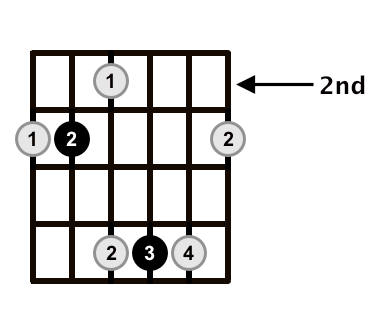

C Major Arpeggio – 5th Position (lowest fret is 5)


C Major Arpeggio – 7th Position (lowest fret is 7)
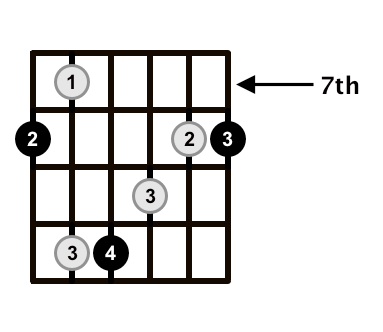

C Major Arpeggio – 8th Position (lowest fret is 8)
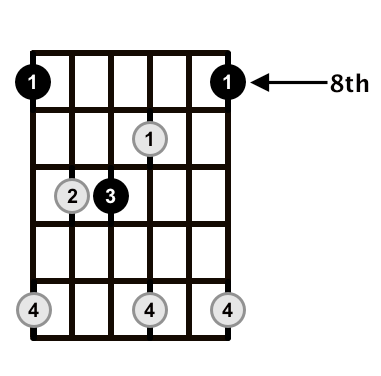

C Major Arpeggio – 12th Position (lowest fret is 12)


More Chord Theory – Minor Chords
This lesson is about arpeggios, but also about chord theory, as they are closely related. We’re going to look at the minor chord now. Earlier, we saw that the major chord is built from the 1st, 3rd, and 5th notes of the major scale. Of course, the minor chord is built from certain notes of a scale also. So… it must be from some sort of minor scale, right? Well, actually, no. We can still use the Major scale to determine which notes the minor chord is built upon. Like I’ve said in a previous lesson, the major scale really is the master scale. The minor chord has the following properties:
- 1 – b3 – 5
The ‘b’ next to the 3 is known as a flat. If you’re not sure what a sharp (#) or a flat (b) is, read the lesson on intervals here.
So the minor chord is built from the 1st, flat 3rd and 5th notes of the major scale. This is why major scales can be used to determine all chords. Even when there is an altered note (such as the flat 3rd), it is still relative to the major scale. It is an indication that we are altering the 3rd note of the major scale. Let’s form a chord using the minor chord theory that we just touched upon.
We’ve already formed an A major chord, so let’s do an A minor chord this time. The 1st, 3rd and 5th notes of the A major scale are:
- A – C# – E
Now we want to ‘flatten’ or ‘lower’ the 3rd (C#). Flattening the C# note results in a C natural (expressed simply as C). Therefor, the A minor chord contains the following notes:
- A – C – E
5 Minor Arpeggio Positions
Let’s now look at the five positions of the minor arpeggio.
A Minor Chord – 3rd Position (lowest fret is 3)
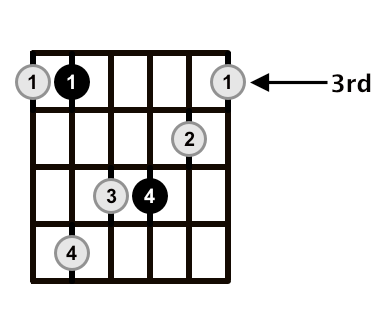

A Minor Chord – 5th Position (lowest fret is 5)


A Minor Chord – 8th Position (lowest fret is 8)
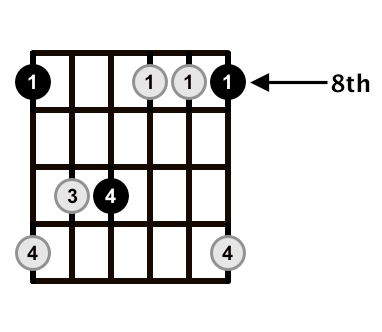

A Minor Chord – 10th Position (lowest fret is 10)
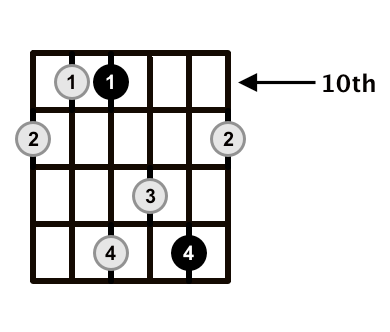

A Minor Chord – 11th Position (lowest fret is 11)
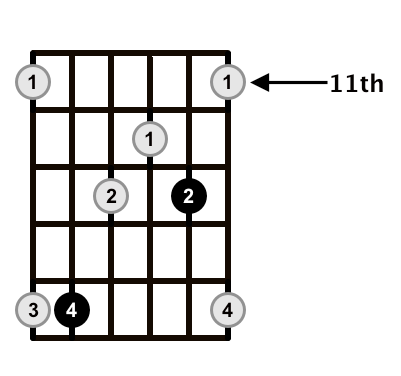

Other Chord Types
By now, you should have a good understanding of what an arpeggio is. We have used major and minor arpeggios as examples, but there are many more. You can visit the arpeggios page of this site to find other arpeggios in all different keys.
Now that you know what arpeggios are, it’s worth talking a little bit about why they are such a powerful tool.
Arpeggios Are Used For Exploring Chords
As you may have noticed, we have spent a lot of this lesson discussing chords. This is because arpeggios effectively are chords, played one note at a time. In many ways, because of the strange layout of the guitar, arpeggios are a better tool for exploring chords and chord theory than chords themselves are. When we learn chords on the guitar, often, we are simply learning shapes that have already been prepared, and then remembering what these shapes are called. This is a great way to build up our chord library, but we don’t necessarily learn a lot about chords in the process. Usually, when we play arpeggios, we go deeper into chord theory, because arpeggios are essentially dissected chords. It’s hard not to learn about augmented chords (for example), when playing augmented arpeggios, because we play each note one at a time.
Arpeggios Are Great For Developing Technique
This is an obvious one but it’s worth pointing out. Because of the large intervals involved with arpeggios, they are technically quite challenging. They are therefor great technical exercises by themselves. Arpeggios often contain difficult left hand fingering combinations and the constant changing from string to string requires the right hand to be very accurate.
Arpeggios Always Sound Good
This may seem like a strange thing to say, but arpeggios generally always sound good, when used in the right context. Using scales tastefully requires a certain mastery of the scales themselves. Using scales straight out of the box can sound clinical and boring. Because arpeggios are really just chords that are played note by note, they always seem to ‘work’ over a chord progression. Of course, there is an art to embellishing arpeggios as well, but if you were to take a chord progression, play the relevant arpeggio over each chord, it would in theory sound quite good. Have a read of this blog post that uses arpeggios over a blues study.
Arpeggios Bring Scales To Life
As I just mentioned, there is an art to using scales musically. One of the most beneficial uses of arpeggios is in bringing a scale to life. Every scale and mode has a default chord that it works best over. The challenge is that getting the scale to outline the chord in a musical way, while still expressing the unique colour of the scale is quite a challenging task. Because arpeggios are inherently chord based, they can be used as the starting point for exploring a scale. This requires a lesson in itself to be explained, and you can read the following lesson for an in depth example.
Summary
We’ve covered a lot of theory in this lesson. Now that we have covered arpeggios, chords and scales, there is a lot of theoretical material that can be explored. A lot of it can seem overwhelming, so it’s important to go at a pace that is comfortable for you. You should think of music theory as a never ending (and fascinating) subject that you can always explore further, while still working on fundamental material (technique, learning to read, learning to play material etc.).
Further Reading
Here are some links to related lessons (some of which have already been linked to previously).
- Arpeggios Page – Here you will find links to different arpeggios in all different keys.
- Using Arpeggios Over A 12 Bar Blues – The title says it all!
- Voice Leading – Voice leading requires a good knowledge of arpeggios.
